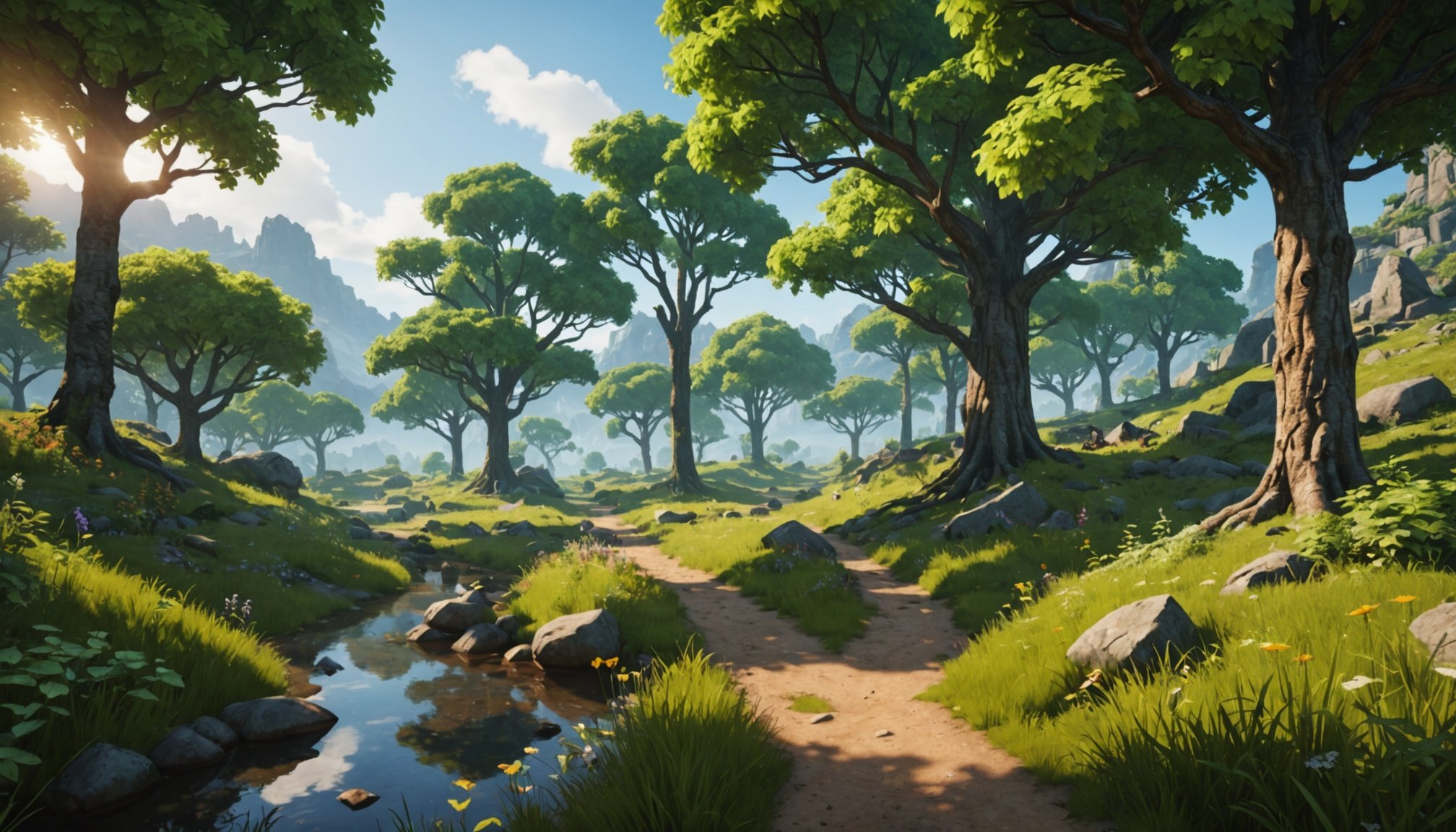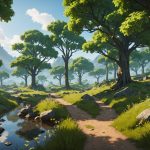Essential Techniques for Enhancing Vegetation in Open-World Games
Creating a vibrant, immersive environment is crucial in adventure gaming, and realistic vegetation plays a significant role. To achieve this, developers leverage various techniques to enhance vegetation, elevating player immersion and overall gameplay experience.
An overview of key game development techniques used for vegetation enhancement includes procedural generation, Level of Detail (LOD) management, and artistic guidelines. Procedural generation allows for diverse and expansive landscapes by algorithmically generating trees, grass, and bushes, thereby introducing variation and richness. Meanwhile, LOD management ensures optimal performance without sacrificing visual quality by adjusting vegetation detail levels based on the player’s proximity.
Also to see : Maximizing Fear Factor: Harnessing Advanced Audio Techniques for Unparalleled Immersion in Horror Gaming
Realistic vegetation demands careful consideration of design principles like color, texture, and scale, which profoundly affect visual aesthetics and player engagement. It’s crucial to align the artistic integration of vegetation with the game’s overall visual style and narrative.
When exploring these techniques, developers should balance technical feasibility with artistic vision. Each method of vegetation enhancement offers unique challenges and opportunities, and a thoughtful approach can significantly enhance the adventure gaming experience. Through meticulous attention to these techniques, developers can craft breathtaking, lifelike worlds that draw players in and keep them engaged.
Have you seen this : Essential Safety Protocols for Mental Health Therapy Games in Virtual Reality: An Essential Guide for Practitioners
Procedural Generation for Vegetation
Procedural generation revolutionizes vegetation creation in game design by employing algorithms to generate detailed and diverse plant life. This process enables developers to craft expansive open-world environments filled with unique trees, shrubs, and grass patches without requiring exhaustive manual design.
The benefits are twofold: saving time in game development and enhancing replayability with ever-changing landscapes. Algorithmic design allows the computer to efficiently create an environment that appears natural and unpredictable, introducing variation in height, density, and species types. This adds realism and depth to adventure gaming experiences, captivating players with a dynamic ecosystem.
Various algorithms, such as L-Systems and Perlin noise, are instrumental in simulating natural growth patterns and terrain variations. For instance, L-Systems are used to replicate plant structures, while Perlin noise assists in crafting organic terrain features. Noteworthy games like “No Man’s Sky” have successfully utilized procedural generation, resulting in vast, visually striking universes.
These game development techniques illustrate how marrying procedural generation with traditional artistry can unlock endless possibilities, shaping worlds that invite exploration and engagement. As a result, players find themselves immersed in vividly lush environments, enhancing their overall adventure experience.
LOD Management Techniques
In the realm of game development, Level of Detail (LOD) management is pivotal for optimizing performance without compromising visual quality. LOD management effectively adjusts the complexity of 3D models based on their distance from the player, ensuring seamless gameplay. It is particularly significant in large open-world environments where numerous assets compete for processing power.
Performance optimization is achieved by swapping high-detail models with lower-detail versions as objects move farther from the player. This approach dramatically reduces the computational load while maintaining an immersive visual experience. For instance, intricate textures and complex polygons are rendered at full quality when close, and simplified as distance increases.
Developers must skilfully balance visual fidelity and performance to maintain player engagement. Techniques such as culling remove unseen models, conserving resources, and optimizing the overall rendering process. Moreover, using dynamic LOD systems allows real-time adjustments to accommodate varying hardware capabilities, ensuring a consistent experience across different platforms.
By employing effective LOD strategies, developers not only enhance the graphical appeal but also extend the reach and playability of their worlds. This delicate balance is crucial for delivering captivating and technically sound adventure gaming experiences.
Artistic Guidelines for Vegetation
Creating visually striking and immersive vegetation in games requires a synergy of artistry and game development techniques. Fundamental design principles guide the process, ensuring vegetation enhances the visual aesthetics and overall experience of adventure gaming.
Color plays a pivotal role in vegetation design; it sets the atmosphere and mood. Developers utilize complementary and contrasting colors to create harmony and draw attention to specific areas, balancing realism and artistic expression. Texture is equally important, as it gives vegetation depth and life. Proper texture mapping can make leaves appear lush and soil seem rich, fostering player immersion. It’s the nuanced details that can make or break an environment’s believability.
Scale must also be carefully considered. Vegetation should be proportionally integrated with other game elements, maintaining consistency in the environment. Oversized foliage can overwhelm, while too small can seem out of place. Games like “The Legend of Zelda: Breath of the Wild” exemplify these principles, skillfully integrating intricate vegetation to enhance player engagement.
Artistic integration of vegetation aligned with the game’s style and narrative enriches the gaming experience. By focusing on these principles, developers create worlds that captivate and inspire players.
Tools and Software for Vegetation Creation
In the intricate world of game development, the right tools and software are crucial for effective vegetation creation. Leveraging the appropriate game development tools not only streamlines the process but also enriches the final product’s visual quality.
Popular Tools
- SpeedTree: Widely acclaimed for its comprehensive features, it’s a go-to for both beginners and seasoned developers. It offers intuitive modeling tools for trees and plants, enabling realistic animations and textures.
- World Machine: Known for terrain editing, it aids in sculpting landscapes that naturally integrate with vegetation assets.
- Houdini: Offers robust procedural generation capabilities, making it ideal for complex ecosystem simulations and seamless environment integration.
Software Features and Benefits
Each tool brings unique strengths. For instance, SpeedTree excels in asset creation with its extensive library and dynamic growth animations. World Machine contributes by reliably generating terrain with finely tuned topography. Meanwhile, Houdini shines with its ability to create highly customizable procedural landscapes, providing developers freedom in design.
Recommendations
For beginners, SpeedTree’s user-friendly interface is a solid choice. However, experienced developers might appreciate Houdini’s depth and flexibility in handling sophisticated projects. Selecting the right software ensures efficient development and captivating visual aesthetics in adventure gaming.
Case Studies of Successful Games
Adventure gaming continually evolves, paralleling advancements in game development techniques. Examining game case studies reveals the pivotal role vegetation enhancement plays in creating immersive worlds. Noteworthy titles like “The Witcher 3: Wild Hunt” and “Horizon Zero Dawn” exemplify the tangible impact of detailed vegetation on player immersion and engagement.
In “The Witcher 3,” vegetation is not merely decorative; it interacts with the environment. Trees sway in the wind, and foliage responds to weather changes, enhancing realism through vegetation enhancement. This intricate attention to detail helps players feel as though they’re traversing a living, breathing world.
“Horizon Zero Dawn” leverages the diverse possibilities of procedural generation to build vast, varied landscapes. This approach not only enriches the visual appeal but also supports dynamic gameplay, where players can strategically use vegetation for stealth or tactical advantages.
These games demonstrate that sophisticated vegetation management fundamentally shapes player experiences, contributing significantly to the narrative depth and emotional connection players feel. By understanding these strategies, developers can appreciate how lush, responsive environments amplify the overall gaming experience.











